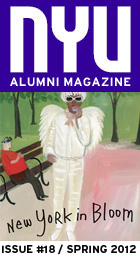libraries
The Real Rosies
A video archive captures the true picture
of a
generation—before they’re gone
by Megan Doll / GSAS ’08
Seated in her bedroom, next to her metalworking tools, 91-year-old Jerre Kalbas recalls laboring at the California Shipyards during World War II. Though her bosses had promised her a promotion within four months of starting, as the date approached, Kalbas realized they planned to stonewall her. Taking matters into her own hands, she applied pressure to the union leader who, seeing that Kalbas was not going to back down, reluctantly secured her promotion and raise. But Kalbas was not satisfied. “I said, ‘Oh, no, not enough. You’re going to get it for all the other women,’ ” she remembers. “And so we got it.”
This story is part of a collection of filmed oral histories, called The Real Rosie the Riveter Project, which aims to capture the experiences of the generation of young women who went to work during the Second World War. In the space of a few years, the number of women in the workforce swelled from 13 to 19 million as they filled the unconventional roles of riveters, welders, mechanics, and drill press operators left vacant by men gone to the fronts.
Time was of the essence for the project, spearheaded by Elizabeth Hemmerdinger (TSOA ’03), as the team set about recording the recollections of these women, now in their eighties and nineties. “There’s something poignant about these very alert, contemplative, philosophical women reflecting at the end of their lives,” says Hemmerdinger, who is at work on a documentary that will bring the archival material, housed by NYU’s Tamiment Library, to a wider audience.
The figure of Rosie the Riveter, who appealed mainly to young women, first appeared in 1942 as the title character of a song by Redd Evans and John Jacob Loeb: “All the day long / Whether rain or shine / She’s part of the assembly line / She’s making history / Working for victory / Rosie the Riveter.” Norman Rockwell later depicted Rosie in a 1943 cover of the Saturday Evening Post, but today we associate her most strongly with J. Howard Miller’s “We Can Do It!” poster, which experienced a resurgence of popularity in the 1980s.
Working women have long been of interest to Hemmerdinger, who volunteered her editorial services to Gloria Steinem’s nascent feminist magazine Ms. in 1971 and, through a bit of bluffing about having some expertise with cars, landed a byline in the iconic July 1972 Wonder Woman issue. Hemmerdinger started working with the archetype of Rosie the Riveter in 2002, as a student in dramatic writing at the Tisch School of the Arts. Her Rosie-inspired play, We Can Do It!, won the Goldberg Playwriting Award in 2003 and enjoyed a brief run at 12 Miles West Theatre Company in New Jersey. A few years later, Hemmerdinger received an unexpected call from country singer and songwriter Larry Gatlin, a former collaborator, and decided to rekindle their partnership by adapting the piece into a musical. She brought on another former collaborator, writer and director Anne de Mare, to help draft the book for the new musical, which they titled Dupsky Does It! Searching for more immediate sources beyond books, films, and websites, they located and interviewed two women in New York City, Jerre Kalbas and Esther Horne, who had worked on the home front.
The interviews gave a sudden dimension to Rosie’s flattened image and would become the seeds of the archive. Hemmerdinger went to Carol A. Mandel, dean of the Division of Libraries, to see whether the Tamiment Library & Robert F. Wagner Labor Archives had any other primary source material. There were a few resources, but Hemmerdinger and library head Michael Nash both saw an opportunity to broaden Tamiment’s collection. They agreed that the library would serve as a repository for the material gathered, and the videos are now available on its website.
The stories that have emerged from the 48 women interviewed in New York, Michigan, Maryland, and Tennessee are varied and richly textured: from Angeline Featherstone Fleming, who relocated from rural Mississippi to Detroit to work as a riveter at Ford Motor Company, to Idilia Johnston, who took a contract with the defense department to escape her authoritarian Scottish father. Despite their variety, one common sentiment among the “Rosies” is an exhilarating sense of newfound independence and economic freedom. “We take that idea of one Rosie, and she steps out of that poster and becomes all these different, very real women with many different lives and experiences,” explains Kirsten Kelly, director of the videos.
While most of the women interviewed returned to their pre-war roles, a handful continued to seek work outside the home. Mildred Crow Sargent, for instance, went on to rivet again during the Korean War. She used the money she saved to pay her way through college and graduate school. Though her husband’s declining health kept her from completing her doctorate, she later published three scholarly books. The war effort also helped Jerre Kalbas explore her talent for working with her hands—something she had had few opportunities to put into practice. Even in her nineties, Kalbas continues to work with metal, fashioning small objects of art out of silver.
Hemmerdinger, de Mare, and Kelly are presently raising funds for a full-length documentary that will weave together the disparate threads of their interviews into a narrative. “We’re hoping to make a film that will be an inspiration to people who don’t even know that this is a part of history,” Hemmerdinger remarks. “Because these stories are not in the history books, except in a glancing way.”
The number of women in the workforce swelled from 13 to 19 million during World War II.







